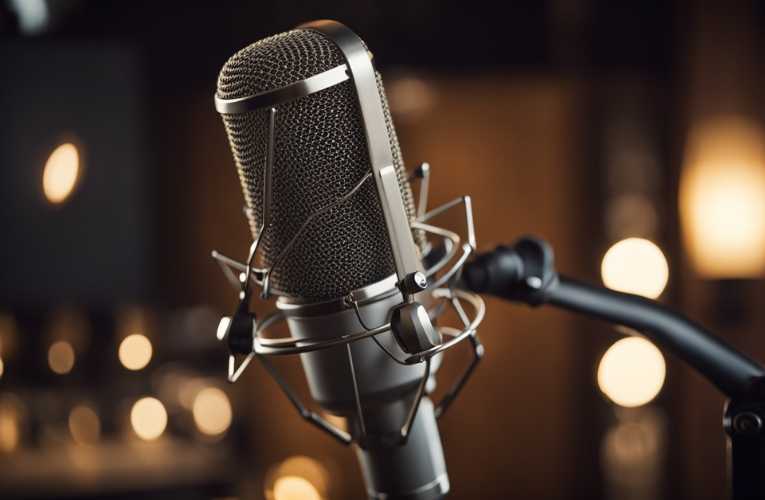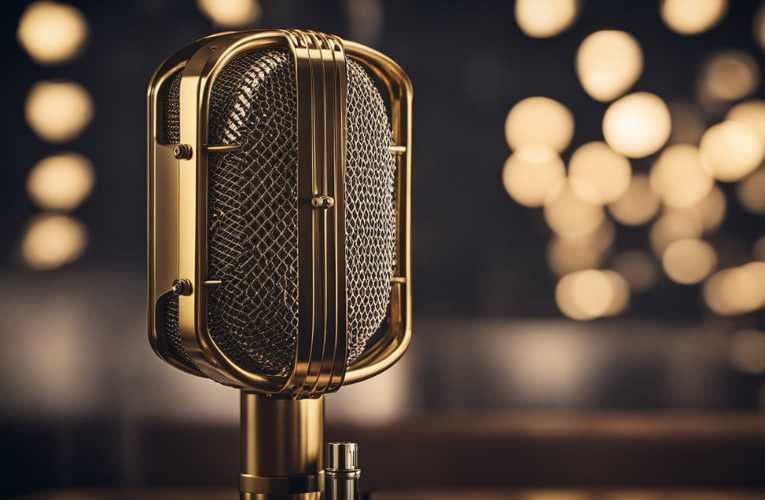What is special about a tube condenser microphone? It’s not just a gadget; it’s the rockstar of sound recording. With its warm, vintage vibes and knack for capturing every whisper and riff, let’s dive into its magical world.
Key Takeaways
- Tube condenser microphones offer a unique and warm sound that cannot be replicated by other types of microphones.
- They consist of five essential components that work together to create their unique sound.
- Tube condenser microphones offer a warm and natural sound, higher sensitivity, and the ability to handle high sound pressure levels without distortion.
Table of Contents
ToggleFundamental Characteristics about a Tube Condenser Microphone

If you’re looking for a microphone that can produce a warm, vintage sound, then a tube condenser microphone might be the right choice for you. Tube condenser microphones are known for their unique sound and have been popular in the music industry for many years. In this section, we will discuss some of the fundamental characteristics of a tube condenser microphone.
Vacuum Tube Functionality
One of the most significant differences between a tube condenser microphone and other types of microphones is the use of a vacuum tube. The vacuum tube in a tube condenser microphone serves as an amplifier for the microphone’s signal. When a condenser microphone captures a signal, the diaphragm outputs a very low-level signal.
That’s where the internal amplifier (sometimes called a head amp) comes in. It’s located inside the microphone and amplifies the signal. The vacuum tube amplifies the signal further, giving it a warm, vintage sound.
Polar Patterns
Another essential characteristic of a tube condenser microphone is its polar pattern. A polar pattern is the directional sensitivity of a microphone. A tube condenser microphone typically has a cardioid polar pattern, which means it picks up sound from the front and rejects sound from the back and sides. This makes it ideal for recording vocals or solo instruments in a studio setting.
Related Posts:
What is Special About a Tube Condenser Microphone

Electrical Components
A tube condenser microphone, also known as a valve microphone, is revered for its unique electrical components. Unlike traditional microphones, tube condenser mics utilize a vacuum tube to amplify the audio signal, resulting in a warmer and more natural sound. The tube imparts a distinct coloration to the audio, often described as rich and harmonically complex. This characteristic makes tube condenser microphones a preferred choice for capturing vocals, acoustic instruments, and other sources that benefit from a vintage, warm tone.
Diaphragm Mechanism
Another special feature of tube condenser microphones lies in their diaphragm mechanism. These microphones are equipped with a condenser capsule that captures sound by converting acoustic waves into electrical signals. The diaphragm is extremely sensitive, allowing for accurate and detailed sound reproduction, particularly in the high-frequency range. This precision makes tube condenser microphones ideal for recording intricate nuances and subtle tonal variations, contributing to their widespread use in professional studio environments.
Usage and Applications of Tube Condenser Microphone

Tube condenser microphones are popular among audio professionals and enthusiasts for their unique sound quality. They are used in a variety of settings, including studio recording and live performance. In this section, we will discuss the different applications of tube condenser microphones.
Studio Recording
Tube condenser microphones are commonly used in studio recording due to their ability to capture a wide frequency range and transient response. They are ideal for recording vocals, acoustic guitars, pianos, and drums. The warm and natural sound of tube condenser microphones can add depth and character to recordings.
In addition, tube condenser microphones are also used for recording orchestral and choral music. They can capture the nuances and subtleties of each instrument and voice, resulting in a rich and detailed sound.
Live Performance
Tube condenser microphones are also used in live performance settings, such as concerts and conferences. They are ideal for capturing the natural sound of acoustic instruments, such as guitars and pianos. They can also be used for vocals, providing a warm and natural sound that is preferred by many performers.
However, tube condenser microphones are not as commonly used in live performance settings as dynamic microphones due to their sensitivity to feedback and their fragility. They require careful handling and placement to avoid damage and interference.
Related Posts:
Comparison with Other Microphones
When it comes to microphones, there are different types available in the market. Each type has its own advantages and disadvantages. In this section, we will compare tube condenser microphones with other types of microphones to see what makes them special.
Tube vs. Solid-State
Solid-state microphones are the most common type of microphones used in the music industry. They are cheaper and more durable than tube microphones. However, they lack the warmth and character of tube microphones. Tube microphones have a more natural and organic sound, which is why they are preferred by many musicians and recording engineers.
Another advantage of tube microphones over solid-state microphones is that they are more forgiving when it comes to recording techniques. They can handle high sound pressure levels without distorting, which makes them ideal for recording loud instruments like drums and electric guitars.
Tube vs. Dynamic Microphones
Dynamic microphones are another popular type of microphones used in the music industry. They are cheaper and more durable than both tube and solid-state microphones. However, they are not as sensitive as tube and solid-state microphones, which means they require more gain to produce the same level of output.
Tube microphones, on the other hand, are more sensitive than dynamic microphones, which means they require less gain to produce the same level of output. They also have a more natural and organic sound, which makes them ideal for recording vocals and acoustic instruments like guitars and pianos.
Related Posts:
- Essential maintenance for tube condenser mics
- Tube condenser microphones vs. solid-state: A detailed comparison
Conclusion
In conclusion, a tube condenser microphone is a special type of microphone that uses vacuum tubes in its internal circuitry. It amplifies the signal and produces a warm, smooth sound that is highly sought after by recording professionals. The tube circuitry adds a unique character to the sound that cannot be replicated by solid-state microphones.
Tube condenser microphones are typically more expensive than their solid-state counterparts, but they are worth the investment if you are serious about recording high-quality audio. They are ideal for recording vocals, acoustic instruments, and other sources that require a natural and warm sound.
When shopping for a tube condenser microphone, consider factors such as the type of vacuum tube used, the polar pattern, and the frequency response. Look for a microphone that suits your specific recording needs and budget. With proper care and maintenance, a tube condenser microphone can last for many years and provide you with unparalleled sound quality.
Related Posts:
Frequently Asked Questions
How do tube condenser microphones differ from solid-state condenser microphones?
Tube condenser microphones differ from solid-state condenser microphones in their internal circuitry. Tube microphones use vacuum tubes in their preamplifier circuit, while solid-state microphones use transistors. This difference affects the sound quality produced by the microphone. Tube microphones tend to produce a warmer and more natural sound, while solid-state microphones produce a more accurate and transparent sound.
What are the advantages of using a tube microphone for vocals?
Tube microphones are often favored for recording vocals because they produce a warm and rich sound that enhances the natural qualities of the voice. The tube circuitry in the microphone adds a subtle harmonic distortion that can make the vocals sound fuller and more present. Additionally, tube microphones have a high sensitivity and low self-noise, which makes them ideal for capturing the nuances and dynamics of a vocal performance.
What characteristics make a tube microphone desirable for studio recording?
Tube microphones are desirable for studio recording because they have a wide frequency response range, which allows them to capture a broad range of sounds with accuracy and detail. Additionally, tube microphones have a high sensitivity and low self-noise, which means they can capture even the quietest sounds without introducing unwanted noise or distortion. The warm and natural sound produced by tube microphones also makes them ideal for recording instruments such as acoustic guitars, pianos, and drums.
Is phantom power required for operating tube condenser microphones?
Yes, phantom power is required for operating tube condenser microphones. Phantom power is a DC voltage that is sent through the microphone cable to power the microphone’s internal circuitry. Tube microphones require a higher voltage than solid-state microphones, so it is important to ensure that your audio interface or mixer can provide the necessary voltage.
How does the sound quality of tube microphones compare to other types of microphones?
Tube microphones are often favored for their warm and natural sound, which is perceived as more pleasing to the ear than the sound produced by other types of microphones. However, the sound quality of a microphone is subjective and can depend on the specific application and personal preference of the user. It is important to test different microphones and make a decision based on your own ears and preferences.
What should be considered when choosing the best tube microphone for a recording setup?
When choosing the best tube microphone for a recording setup, several factors should be considered, including the microphone’s frequency response, sensitivity, self-noise, and polar pattern. It is also important to consider the specific application and the sound you are trying to achieve. Different microphones have different tonal characteristics and may be better suited for certain instruments or vocalists. Lastly, it is important to consider the budget and ensure that the microphone is compatible with your existing equipment.








